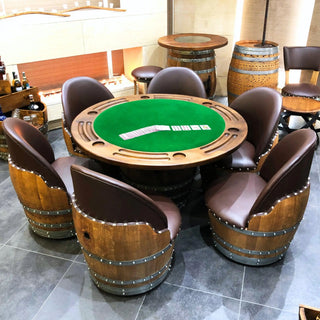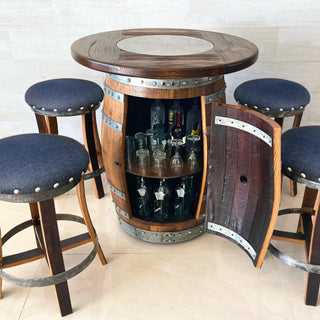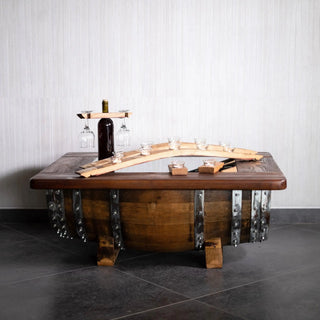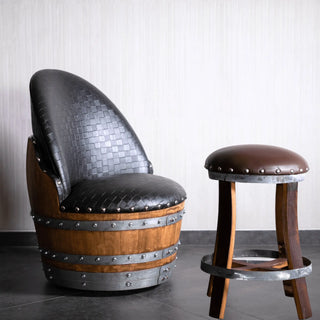
Unique History & Craftsmanship - Wine Barrels
How to Make a Wine Barrel
For millennia, wine barrels have been an indispensable component in the vinification process. The craft of building barrels has a long and storied history, and it is an art that has been handed down from one generation to the next. In the next posts, we will discuss the origin of wine barrels, how wine barrels are crafted, and the influence that wine barrels have on the flavor of wine.
Since the Middle Ages, people have been storing wine in barrels for a variety of reasons. In point of fact, the usage of barrels for storing wine may be traced all the way back to the times of the ancient Greeks and Romans. These early barrels were used to store and transport wine, and they were crafted from a variety of woods including oak, chestnut, and ash, among other types of wood. Oak barrels were eventually utilized by vintners from every corner of the globe after their utilization became increasingly commonplace over the course of time.
Oak barrels are still widely used in the manufacture of wine even in modern times, and the vast majority of wine barrels are either made in the United States or in France. The ultimate flavor and aroma of the wine are strongly influenced by the type of oak that was used to age the wine, thus selecting the right oak is essential. During the aging process, the oak contributes a variety of flavors, including vanilla, cinnamon, and toast, which are then transferred into the wine. These flavors may be found in the finished product.
So, tell me, how do they make wine barrels? Making wine barrels is a labor-intensive operation that takes a significant amount of time and calls for a high level of skill as well as close attention to detail. The first thing that needs to be done is choose the kind of oak that will be used. The flavors of American oak are believed to be sweet, vanilla-like, and toasted, but the flavor profile of French oak is regarded to be more refined and peppery in nature.
After the oak has been chosen, it is time to begin the process of coopering the barrels. First, the oak is cut into staves, which are the long, thin pieces of wood that make up the sides of the barrel. These staves are used to construct the barrel. After that, the staves are allowed to air-dry for anywhere from several months to an entire year in order to limit the amount of moisture in the wood and ensure that it is stable.
The staves are then heated over a fire in order to make them more malleable in the following step. Toasting is a procedure that helps produce tastes and aromas that will be transferred into the wine. It is one of the steps in the winemaking process. There is a range of possible degrees of toasting, with light toasting producing flavors that are more subtle and dark toasting producing sensations that are more powerful.
After the staves have been roasted, they are curved and formed into a circle using bending and shaping techniques. After being assembled with a bottom and a top, the staves are first secured to one another using metal hoops. After that, a coating of hot wax is spread around the interior of the barrel to help prevent leaks and to assist in the process of sealing the barrel.
After the barrel has been constructed in its entirety, it is then put aside to dry and age. During this time, the oak will proceed to impart more of its flavors and aromas into the wine that it is aging. The amount of time it takes for the barrel to cure is going to vary depending on the type of oak that was used, the size of the barrel, and the climate.
After the wine barrel has been cured, it can then be filled with the desired amount of wine. The wine will be aged in the barrel for a certain amount of time, which can range anywhere from a few months to a few years depending on the type of wine and the taste profile that is wanted. The wine will interact with the oak during this time, and as a result, it will pick up the tastes and aromas that the barrel has to offer.
Since ancient times, people have been storing wine in barrels, which has had a considerable influence on both the flavor and scent of the wine. Making wine barrels is a labor-intensive operation that takes a significant amount of time and calls for a high level of skill as well as close attention to detail. To produce a high-quality wine barrel that will impart its one-of-a-kind flavors and aromas into the wine, every step of the cooperage process is meticulously crafted to produce a high-quality wine barrel. This begins with the selection of the oak and continues through the toasting and curing processes.
To summarize, the craft of constructing wine barrels has been practiced for many generations and is an indispensable component of the manufacture of wine. The wine industry has adopted the use of oak barrels as a normal practice, and the manufacturing process for wine barrels has been refined over the years to produce high-quality barrels that will improve the flavor and aroma of the wine. Oak barrels have become the industry standard. It is impossible to deny the influence that a wine barrel has on the finished product; in addition, the toasting of the wood, the careful selection of oak, and the aging process all contribute to the one-of-a-kind personality of the wine. It is impossible to ignore the part that wine barrels play in the process of making wine, regardless of whether one is a winemaker, a wine connoisseur, or simply someone who enjoys a good glass of wine.
Since the Middle Ages, people have been storing wine in barrels for a variety of reasons. In point of fact, the usage of barrels for storing wine may be traced all the way back to the times of the ancient Greeks and Romans. These early barrels were used to store and transport wine, and they were crafted from a variety of woods including oak, chestnut, and ash, among other types of wood. Oak barrels were eventually utilized by vintners from every corner of the globe after their utilization became increasingly commonplace over the course of time.
Oak barrels are still widely used in the manufacture of wine even in modern times, and the vast majority of wine barrels are either made in the United States or in France. The ultimate flavor and aroma of the wine are strongly influenced by the type of oak that was used to age the wine, thus selecting the right oak is essential. During the aging process, the oak contributes a variety of flavors, including vanilla, cinnamon, and toast, which are then transferred into the wine. These flavors may be found in the finished product.
So, tell me, how do they make wine barrels? Making wine barrels is a labor-intensive operation that takes a significant amount of time and calls for a high level of skill as well as close attention to detail. The first thing that needs to be done is choose the kind of oak that will be used. The flavors of American oak are believed to be sweet, vanilla-like, and toasted, but the flavor profile of French oak is regarded to be more refined and peppery in nature.
After the oak has been chosen, it is time to begin the process of coopering the barrels. First, the oak is cut into staves, which are the long, thin pieces of wood that make up the sides of the barrel. These staves are used to construct the barrel. After that, the staves are allowed to air-dry for anywhere from several months to an entire year in order to limit the amount of moisture in the wood and ensure that it is stable.
The staves are then heated over a fire in order to make them more malleable in the following step. Toasting is a procedure that helps produce tastes and aromas that will be transferred into the wine. It is one of the steps in the winemaking process. There is a range of possible degrees of toasting, with light toasting producing flavors that are more subtle and dark toasting producing sensations that are more powerful.
After the staves have been roasted, they are curved and formed into a circle using bending and shaping techniques. After being assembled with a bottom and a top, the staves are first secured to one another using metal hoops. After that, a coating of hot wax is spread around the interior of the barrel to help prevent leaks and to assist in the process of sealing the barrel.
After the barrel has been constructed in its entirety, it is then put aside to dry and age. During this time, the oak will proceed to impart more of its flavors and aromas into the wine that it is aging. The amount of time it takes for the barrel to cure is going to vary depending on the type of oak that was used, the size of the barrel, and the climate.
After the wine barrel has been cured, it can then be filled with the desired amount of wine. The wine will be aged in the barrel for a certain amount of time, which can range anywhere from a few months to a few years depending on the type of wine and the taste profile that is wanted. The wine will interact with the oak during this time, and as a result, it will pick up the tastes and aromas that the barrel has to offer.
Since ancient times, people have been storing wine in barrels, which has had a considerable influence on both the flavor and scent of the wine. Making wine barrels is a labor-intensive operation that takes a significant amount of time and calls for a high level of skill as well as close attention to detail. To produce a high-quality wine barrel that will impart its one-of-a-kind flavors and aromas into the wine, every step of the cooperage process is meticulously crafted to produce a high-quality wine barrel. This begins with the selection of the oak and continues through the toasting and curing processes.
To summarize, the craft of constructing wine barrels has been practiced for many generations and is an indispensable component of the manufacture of wine. The wine industry has adopted the use of oak barrels as a normal practice, and the manufacturing process for wine barrels has been refined over the years to produce high-quality barrels that will improve the flavor and aroma of the wine. Oak barrels have become the industry standard. It is impossible to deny the influence that a wine barrel has on the finished product; in addition, the toasting of the wood, the careful selection of oak, and the aging process all contribute to the one-of-a-kind personality of the wine. It is impossible to ignore the part that wine barrels play in the process of making wine, regardless of whether one is a winemaker, a wine connoisseur, or simply someone who enjoys a good glass of wine.
Interested in shopping for wine barrel furniture? You can browse our full collection of items ranging from coffee tables to home bar and game sets here!
www.obarrel.com/collections
www.obarrel.com/collections





